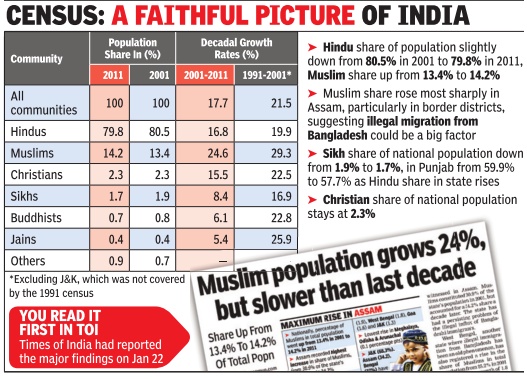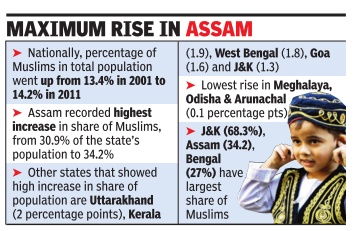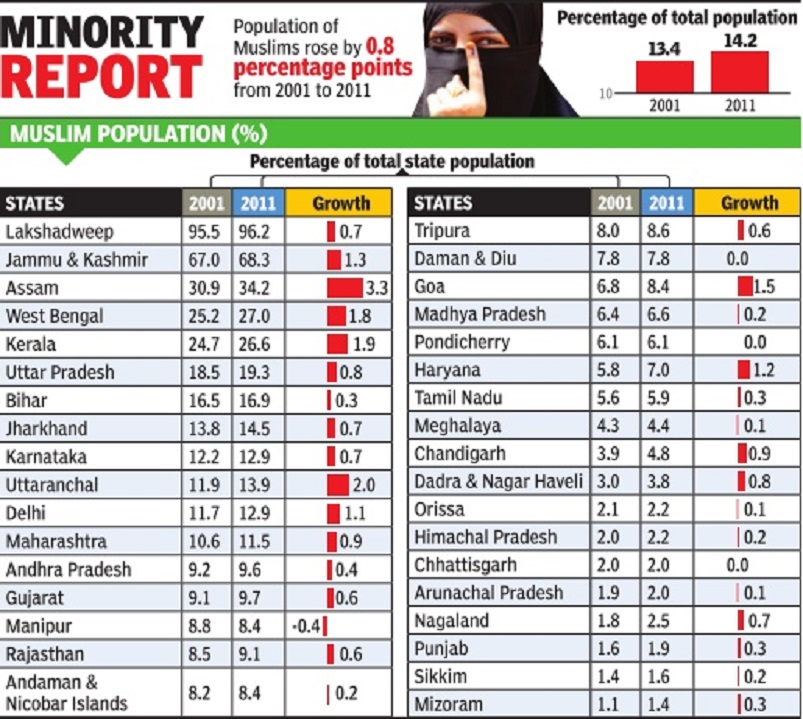Religion-wise demographics: Muslim population in India, after 1947
This is a collection of articles archived for the excellence of their content. |
Contents |
Changes in fertility rate, population
1901-2011
Ali Mehdi, August 27, 2019: The Times of India
The Prime Minister expressed concern about ‘population explosion’ in his Independence Day speech, and referred to those with small families as patriotic, ‘responsible citizens’. Last month, BJP MP Rakesh Sinha introduced the Population Regulation Bill, 2019, in the Rajya Sabha. He later claimed that his Bill was not aimed at any religion, caste or community. Regardless, the Shiv Sena targeted a section of the Muslims for their supposedly high birth rates (‘hum do, humare pachhis’ – we 2, our 25). Last year, BJP MP Giriraj Singh went to the extent of claiming that “one particular community is responsible for increasing the population of the country and that is curbing the nation’s development”, even as Shiv Sena called for “compulsory sterilisation” of Muslims.
None of this is new. Religious differences in birth rates have often been a matter of hot political debate in India since the early 1900s. Thankfully, India has had a long history of very rich and reliable demographic data which can be used to assess whether such concerns are well-founded.
India’s population has increased by more than 5 times in the last 110 years, from 238 million in 1901 to 1,211 million in 2011. Most of the increase (87%) happened in the post-Independence era (1951-2011). The highest population growth was 24.8% during 1961-71, after which the growth rate started declining, going down to 17.7% during 2001-11. A report by the National Institute for Heath and Family Welfare, ‘The Story of India’s Population’ (2014), confirms that “India has witnessed a steady decline in its population growth rate over the last four decades (1971–2011).”
However, with a huge population as ours, even decreasing growth rate means massive additions to the total population size. So, despite declining growth rates during 1971-2011, we added 663 million to our population in this period. And not 2050, India will become the world’s most populous country in 2027 itself, according to estimates by UN World Population Prospects 2019. So, yes, the population explosion has happened and continues to happen. Are Muslims responsible for India’s population explosion? Muslims contributed 14.6% (1901-2011), 16.1% (1951-2011) and 16.7% (1971-2011) to India’s population growth. The contribution of Hindus, on the other hand, was 79.4%, 78% and 77.4% and that of the rest was 6%, 5.9% and 5.9% during these periods. In 1901, Hindus outnumbered Muslims in India by 164 million; by 268 million in 1951; 392 million in 1971; and by 794 million in 2011. So, despite a lower growth rate, but a much higher population, the numerical advantage of Hindus has grown over the years, rather than the other way round.
At the same time, the population growth rate of Muslims has been declining since 1971 – from 30.9% during 1961-71 to 24.6% during 2001-11. If population explosion is what you are concerned about, do not bother about the Muslims so much.
A higher total fertility rate (TFR) – births per woman – among Muslims is often referred to as a cause for alarm (religious, demographic and developmental). Allow me to clarify. Population change is determined by three demographic variables – fertility, mortality and migration – and not by fertility alone. You can have a high fertility rate, but if your mortality or migration rates are high, your population won’t increase.
These demographic variables are, in turn, determined by socioeconomic factors (type of residence, education, economic status, etc) as well as by culture, religion, sense of security, etc – and not by religion alone. The TFR of Muslims in Uttar Pradesh is 3.10, while it is 1.86 in Kerala – much less than that of Hindus in UP (2.67), according to the fourth round (2015-16) of the National Family Health Survey (NFHS-4).
TFR in rural India was 2.41 and 1.75 in urban India, while their under-five mortality rate (U5MR) was 55.8 and 34.4 respectively. Similarly, at the national level, among women aged 15-49 years with no schooling and those with 12 or more years schooling, TFR was 3.06 and 1.71 respectively, while U5MR was 67.5 and 26.5. Among those in the lowest and the highest wealth index, TFR was 3.17 and 1.54 respectively, while U5MR was 71.7 and 22.6. TFR of Muslims and Hindus was 2.61 and 2.13 respectively, while their U5MR was 49.9 and 50.5, at the all-India level. Muslims have had an advantage over Hindus in child survival for a very long time, and it has only declined over time. One aspect of mortality is life expectancy at birth (LEB). There was a difference of 4 years between LEB of poor Muslims (65.5 years) and Hindus (61.5 years) during NFHS-3 (2005-06), the difference being miniscule between non-poor Muslims (68.4 years) and Hindus (67.8 years).
So, it is not just due to higher TFR, but also higher child and adult survival rates that the population growth rate among Muslims has been relatively higher.
Furthermore, TFR declined by 40.8% among Muslims vis-a-vis 35.7% at the national level and 35.5% among Hindus between NFHS-1 (1992-93) and NFHS-4. It will decline further if their socioeconomic characteristics, sense of security, etc improve. Only 9.2% of Muslim females aged 6+ years vis-a-vis 14% Hindu females had 12 or more years of schooling; for males, it was 12.7% and 21% respectively (NFHS-4). In 2011-12, 25.4% Muslims and 21.9% Hindus were below the poverty line (Tendulkar methodology). Despite differentials in socioeconomic deprivation, the situation of both Hindus and Muslims is worrisome, and this is what needs to be addressed to stop the population exploding further.
Population figures
Recent analyses of India’s own data by the Pew Research Centre, a non-partisan US think tank shows that:
The Muslim population share has indeed risen in every census since independence, from 9.8% in 1951 to 14.2% in 2011. The Hindu share has fallen from 84.1% to 79.8%. The 2021 census has been postponed because of Covid. The rise of 4.4% population share for Muslims in six decades has been very gradual. Continuation of this trend would make the Muslim population share no more than 20% at century-end. In fact, the increase will be much less because the gap between Muslim and Hindu fertility is falling fast and may close altogether in the foreseeable future.
The National Family Health Survey of 1992-2015 is the most recent authoritative source of fertility data. In this period, the total fertility rate of Muslims — number of children per woman — has fallen steeply from 4.4 to 2.6. The fertility rate for Hindus has declined more slowly, from 3.3 to 2.1. Clearly Muslims are adopting family planning at a faster rate than Hindus after a late start.
The Pew Centre notes that the fertility gap between Muslims and Hindus was 1.1 children in 1992, and has more than halved to 0.5 children in 2015. If this trend continues, the gap should disappear altogether in a little over two decades. In short, there is no threat whatsoever to the … preponderance of Hindus in India.
Migration is another possible cause of changes in population share of different communities. But the Pew Centre found that as many as 99% of Indians counted in the last census were also born in India. It is not well known that out-migration from India is thrice that of in-migration…
In 2015, 15.6 million people born in India were living abroad. By contrast, in-migrants — people born abroad but living in India — numbered only 5.6 million. Possibly inmigrants are undercounted but there is no evidence to show the numbers are large. The biggest inflow has come from Bangladesh (3.2 million), Pakistan (1.1 million), Nepal (540,000), and Sri Lanka (160,000), and many are Hindus.
More Muslims are migrating out of India than into India. The biggest out-migration destinations are the United Arab Emirates (3.5 million), Pakistan (2 million) and the US (2 million).
Muslims account for 27% of out-migrants against their population share of just 14.2%. Hindus account for only 45% of out-migrants against their population share of 79%. The biggest imbalance relates to Christians with 17% of out-migrants against their population share of 3%.
Conversions: the population share of Christians has stayed at 2.3% from 1951 to 2015.
2011: 14.2% of Indians are Muslim
Muslim population grows 24%, but slower than last decade
Bharti Jain The Times of India
Share Up From 13.4% To 14.2% Of Total Popn
The 2011 census data on the population of religious groups shows a 24% rise in the Muslim population between 2001 and 2011, with the community's share of India's total population rising from 13.4% to 14.2% over the 10-year period.
While the growth rate of the Muslim population has slowed from the figure of around 29% recorded between 1991 and 2001, it is still higher than the national av erage of 18% for the decade.
The data accessed by TOI shows that the most rapid rise in the share of Muslims in the total population was witnessed in Assam. Muslims constituted 30.9% of the state's population in 2001, but accounted for a 34.2% share a decade later. The state has had a persisting problem of the illegal influx of Bangladeshi immigrants.
West Bengal, another state where illegal immigration from Bangladesh has been an old phenomenon, has also registered a rise in the share of Muslims in total population from 25.2% in 2001 to 27% in 2011, a growth of 1.8 percentage points over the 10 years, more than double the national average. Uttarakhand reported a sharp rise in the share of Muslim population from 11.9% to 13.9%, a growth of 2 percentage points against the countrywide growth of 0.8 percentage points between 2001 and 2011.
Other states with a significant rise in the share of Muslims in the total population as per the 2011 census were Kerala (from 24.7% to 26.6%), Goa (6.8% to 8.4%), Jammu & Kashmir (67% to 68.3%), Haryana (5.8% to 7%) and Delhi (11.7% to 12.9%).
The census office had compiled this data by March last year, but the UPA government held back the release, perhaps fearing political repercussions of the findings on the eve of Lok Sabha elections. Union home minister Rajnath Singh last week gave his go-ahead when Registrar General of India and Census Commissioner C Chandramouli asked whether the “sensitiive“ figures should be released.
Singh confirmed that the data would be made public soon.
Interestingly , Manipur was the only state to show a fall in Muslim population as a percentage of its total population (a fall of 0.4 percentage points).
The high growth of Muslim population in Assam has been intensely debated and has been a source of political confrontation. In fact, a re port prepared on the issue in 1998 by the then governor of Assam, Lt Gen (Retd) S K Sinha, had warned that illegal immigration was slowly changing the demographic profile in several districts.The Supreme Court has on more than one occasion expressed concern over the change in demography and chided the government for not stopping infiltration from Bangladesh.
2001-11: Increase in population
See graphic, ' Increase in India’s Muslim population: 2001-11 '
2011: Rise in Muslim population
The Times of India, Aug 26 2015

Census: Kerala, U'khand saw rise in Muslim population
The share of Hindus in India's population came down a tad from 80.5% in 2001 to 79.8% in 2011, while the share of Muslims rose from 13.4% to 14.2%, Census data released on Tuesday showed.Among the other large religious communities, Christians remained at 2.3% of the population and the Jains at 0.4%, while Sikhs dropped slightly from 1.9% to 1.7% and Buddhists from 0.8% to 0.7%, the data showed. The official release confirmed what TOI had reported a good seven months earlier, on January 22. The Census has had the data ready for over a year, but had not made it public. Coming as it does in the build-up to the assembly elections in Bihar, the data could stir up even greater heat and passion than it would normally .
In line with the overall decline in the decadal growth rate of the country's population, all religious communities have seen the growth rates of their populations de DIVINE NUMBERS: P 24 clining sharply in the 20012011 period, compared to the rates in the earlier decade.The lowest decline was recorded among Hindus, from 19.9% to 16.8%.
While the national shares of different religious groups have changed only marginally, the changes are somewhat more sizeable in states like Assam, West Bengal, Kerala, Punjab, Uttarakhand and some states in the northeast.
In Assam, for instance, the share of Muslims in the total population has increased from 30.9% in 2001 to 34.2% in 2011. That illegal migration from Bangladesh is playing a part in this is evident from the fact that nine of the state's 27 districts are now Muslim-majority compared to six of 23 earlier. All of these districts are in the areas bordering Bangladesh.
In West Bengal too, the Muslims in 2011 constituted 27% of the population against 25.2% a decade earlier, though in this case the border districts do not show a no ticeable jump in minority population shares compared to 2001. Uttar Dinajpur has joined Malda and Murshidabad in the list of districts where Muslims outnumber Hindus, though at 49.9% they are just short of being an outright majority . Kerala and Uttarakhand have also registered significant increases in the share of the Muslims in their population, while in many other states there is a small increase in the share of Muslims.
In Punjab, on the other hand, the share of Hindus has increased from 36.9% to 38.5%, with the share of Sikhs dropping from 59.9% to 57.7%. The Sikhs have also declined from 16.1% to 13.1% of Chandigarh's population and from 4.0% to 3.4% of Delhi. The Hindu share of population has also risen by one percentage point in Nagaland, and more marginally in Karnataka and Goa and in some of the union territories like.
In Arunachal Pradesh and Manipur, the Christians formed a significantly larger share of the population in 2011 than they did in 2001. In Arunachal, their share rose from 18.7% to 30.3%, while in Manipur it rose from 34% to 41.3%, which is just a little lower than the 41.4% share of population that Hindus have in the state.
2011: State-wise distribution
See graphic, '2011: State-wise distribution of the Muslim population in India '
See also
Muslims: India (after 1947) <>
Muslims in central India: 1916 <>
Religion-wise demographics: Muslim population in India, after 1947
…and countless other articles about Muslim communities by clicking the Communities link below or by entering a word or phrase in the Search rectangle on the top right of this page.

